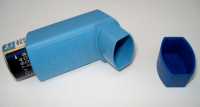
15 Sep Inhaled Steroids Associated With Increased Risk of Atypical Mycobacterial Infections
MedicalResearch.com Interview with:
Stephen J Ruoss MD
Professor, Stanford University, Medicine,
Division of Pulmonary and Cfritical Care Medicine
Stanford, California
MedicalResearch.com: What is the background for this study? Would you briefly explain what is meant by an atypical mycobacterial infection?
Response: Our interest in undertaking this study stems from three important clinical observations and issues.
First, the use of inhaled steroid medications for a broad variety of respiratory complaints and diseases is increasing, including in clinical circumstances where there isn’t much strong supportive evidence for benefit to patients from using inhaled steroids.
The second observation is that steroids can and do alter immune system responses, and can increase the risk for some infections. There are already data from studying patients on inhaled steroids where the incidence of bacterial respiratory infections has increased, supporting the concerns for infection risk from inhaled steroids.
And the third issue is that steroids can more specifically alter immune system function that helps combat mycobacterial infections, and this means that the risk for, and incidence of mycobacterial infections could be increased in patients treated with inhaled steroids. The best known mycobacterial infection is of course tuberculosis, but there are other mycobacteria, called nontuberculous mycobacterial (or atypical mycobacterial) that are broadly found in the environment, and some of those nontuberculous mycobacteria (NTM) can cause lung infections.
So our hypothesis was that the use of inhaled steroids might be associated with an increased frequency of NTM infections, and we designed the study to explore that hypothesis.
MedicalResearch.com: What are the main findings?
Response: We performed a retrospective study in a very large population of patients in the Kaiser Permanent heal care system, and compared patients with chronic lung diseases (including COPD, bronchiectasis and asthma) with regard to both treatment with inhaled steroids and the presence or absence of NTM infections.
What we found was that with chronic airways diseases who were treated with inhaled steroids were at an increasing risk for developing NTM infections, and that the risk of infection increased with increasing dose and duration of steroid therapy.
MedicalResearch.com: What should readers take away from your report?
Response: Inhaled steroids can be beneficial, and there are diseases where there are clear benefits for patients when they are treated with inhaled steroids; the best supported disease in this regard is asthma. But inhaled steroids do not provide benefit in everyone with chronic airway obstruction disease, and can cause increased risk for infections, as our study suggests. Our study also supports two recent preceding and independent studies, one in Europe and one from Canada, that used somewhat different study approaches, but each reached a conclusion that is in complete agreement with the results of our study. This each of these three studies supports the other, and makes more likely that the conclusions are real and important.
One very important clinical conclusion from this report is that the use of inhaled steroids should be reserved for patients who derive clear benefit from this treatment (either by clear symptoms improvement, or by improvement in pulmonary function by testing, or both. And if there is no clear benefit from a trial of treatment with inhaled steroids, the treatment should be stopped.
MedicalResearch.com: What recommendations do you have for future research as a result of this work?
Response: It may be helpful to have other investigators do added studies to corroborate our findings. Ideally, a prospective study would most clearly answer the remaining questions about whether this effect is clinically important, and that NTM infection risk is definitely linked to inhaled steroid exposure, but that study would likely require a very large patient population studied over a long period, and is thus less likely to ever be undertaken.
It would also be appropriate for independent pulmonary disease organizations such as the American College of Chest Physicians, the American Thoracic Society, and the European Respiratory Society, to consider the very consistent findings from our study and the other two noted above, and consider making recommendations regarding the growing and broad use of inhaled steroids in clinical circumstances where the risk of problems, including infections, may be greater that than the likelihood of any symptoms or functional benefit from inhaled steroid treatment.
Citation:
Association between Inhaled Corticosteroid Use and Pulmonary Nontuberculous Mycobacterial Infection
Vincent X Liu , Kevin L Winthrop , Yun Lu , Husham Sharifi , Hekmat U Nasiri , and Stephen J Ruoss
https://doi.org/10.1513/AnnalsATS.201804-245OC PubMed: 30213194
Published Online: September 14, 2018
I have no intellectual nor commercial conflicts of interest regarding the contents of this manuscript.
[wysija_form id=”3″]
[last-modified]
The information on MedicalResearch.com is provided for educational purposes only, and is in no way intended to diagnose, cure, or treat any medical or other condition. Always seek the advice of your physician or other qualified health and ask your doctor any questions you may have regarding a medical condition. In addition to all other limitations and disclaimers in this agreement, service provider and its third party providers disclaim any liability or loss in connection with the content provided on this website.
Last Updated on September 16, 2018 by Marie Benz MD FAAD

